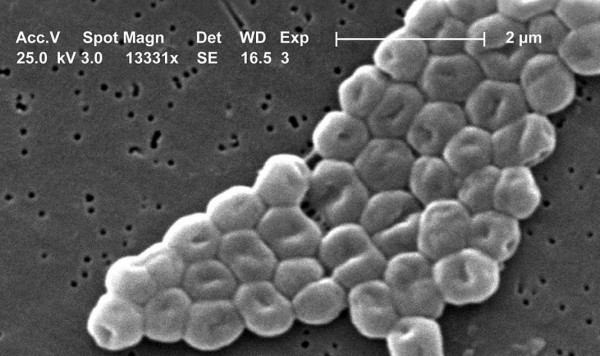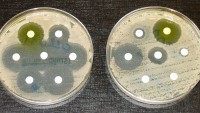WHO lists 12 Deadliest Antimicrobial Resistant Superbugs that Must be Overcome by New Antibiotics
| Arthur Dominic Villasanta | | Feb 27, 2017 08:07 PM EST |
(Photo : WHO) Acinetobacter.
The World Health Organization (WHO) raised an urgent alarm about the growing danger from superbugs with antimicrobial resistance (AMR) by publishing its first ever list of these superbugs that pose the greatest threat to human health.
WHO's antibiotic-resistant "priority pathogens" are a catalogue of 12 families of bacteria. The list was put together in a bid to guide and promote research and development (R&D) of new antibiotics as part of WHO's efforts to address growing global danger of AMR.
Like Us on Facebook
The list specifically highlights the threat of gram-negative bacteria resistant to multiple antibiotics. These bacteria have built-in abilities to find new ways to resist treatment and can pass along genetic material that allows other bacteria to become drug-resistant, as well.
"This list is a new tool to ensure R&D responds to urgent public health needs," said Dr. Marie-Paule Kieny, WHO's Assistant Director-General for Health Systems and Innovation.
"Antibiotic resistance is growing, and we are fast running out of treatment options. If we leave it to market forces alone, the new antibiotics we most urgently need are not going to be developed in time."
WHO's list is divided into three categories according to the urgency of need for new antibiotics: critical, high and medium priority.
The most critical group of all includes multidrug resistant bacteria that pose a particular threat in hospitals, nursing homes and among patients whose care requires devices such as ventilators and blood catheters.
These multidrug resistant bacteria include Acinetobacter, Pseudomonas and various Enterobacteriaceae (including Klebsiella, E. coli, Serratia, and Proteus). They can cause severe and often deadly infections such as bloodstream infections and pneumonia.
These bacteria have become resistant to a large number of antibiotics, including carbapenems and third generation cephalosporins - the best available antibiotics for treating multi-drug resistant bacteria.
The second and third tiers in the list -- the high and medium priority categories -- contain other increasingly drug-resistant bacteria that cause more common diseases such as gonorrhoea and food poisoning caused by salmonella.
The list is intended to spur governments to put in place policies that incentivize basic science and advanced R&D by both publicly funded agencies and the private sector investing in new antibiotic discovery.
It will provide guidance to new R&D initiatives such as the WHO/Drugs for Neglected Diseases initiative (DNDi) Global Antibiotic R&D Partnership that is engaging in not-for-profit development of new antibiotics.
Tuberculosis -- whose resistance to traditional treatment has been growing in recent years -- was not included in the list because it is targeted by other, dedicated programs. Other bacteria not included, such as streptococcus A and B and chlamydia, have low levels of resistance to existing treatments and do not currently pose a significant public health threat.
The list was developed in collaboration with the Division of Infectious Diseases at the University of Tübingen, Germany, using a multi-criteria decision analysis technique vetted by a group of international experts.
"New antibiotics targeting this priority list of pathogens will help to reduce deaths due to resistant infections around the world," said Prof Evelina Tacconelli, Head of the Division of Infectious Diseases at the University of Tübingen and a major contributor to the development of the list.
"Waiting any longer will cause further public health problems and dramatically impact on patient care."
While more R&D is vital, alone, it cannot solve the problem. To address resistance, there must also be better prevention of infections and appropriate use of existing antibiotics in humans and animals, as well as rational use of any new antibiotics that are developed in future.
WHO priority pathogens list for R&D of new antibiotics:
Priority 1: CRITICAL
Acinetobacter baumannii, carbapenem-resistant
Pseudomonas aeruginosa, carbapenem-resistant
Enterobacteriaceae, carbapenem-resistant, ESBL-producing
Priority 2: HIGH
Enterococcus faecium, vancomycin-resistant
Staphylococcus aureus, methicillin-resistant, vancomycin-intermediate and resistant
Helicobacter pylori, clarithromycin-resistant
Campylobacter spp., fluoroquinolone-resistant
Salmonellae, fluoroquinolone-resistant
Neisseria gonorrhoeae, cephalosporin-resistant, fluoroquinolone-resistant
Priority 3: MEDIUM
Streptococcus pneumoniae, penicillin-non-susceptible
Haemophilus influenzae, ampicillin-resistant
Shigella spp., fluoroquinolone-resistant
TagsWorld Health Organization, WHO, antimicrobial resistance, superbugs, priority pathogens, antimicrobial medicines, multidrug resistant bacteria
©2015 Chinatopix All rights reserved. Do not reproduce without permission
EDITOR'S PICKS
-

Did the Trump administration just announce plans for a trade war with ‘hostile’ China and Russia?
-

US Senate passes Taiwan travel bill slammed by China
-

As Yan Sihong’s family grieves, here are other Chinese students who went missing abroad. Some have never been found
-

Beijing blasts Western critics who ‘smear China’ with the term sharp power
-

China Envoy Seeks to Defuse Tensions With U.S. as a Trade War Brews
-

Singapore's Deputy PM Provides Bitcoin Vote of Confidence Amid China's Blanket Bans
-

China warns investors over risks in overseas virtual currency trading
-

Chinese government most trustworthy: survey
-

Kashima Antlers On Course For Back-To-Back Titles
MOST POPULAR
LATEST NEWS
Zhou Yongkang: China's Former Security Chief Sentenced to Life in Prison

China's former Chief of the Ministry of Public Security, Zhou Yongkang, has been given a life sentence after he was found guilty of abusing his office, bribery and deliberately ... Full Article
TRENDING STORY

China Pork Prices Expected to Stabilize As The Supplies Recover

Elephone P9000 Smartphone is now on Sale on Amazon India

There's a Big Chance Cliffhangers Won't Still Be Resolved When Grey's Anatomy Season 13 Returns

Supreme Court Ruled on Samsung vs Apple Dispute for Patent Infringement

Microsoft Surface Pro 5 Rumors and Release Date: What is the Latest?














